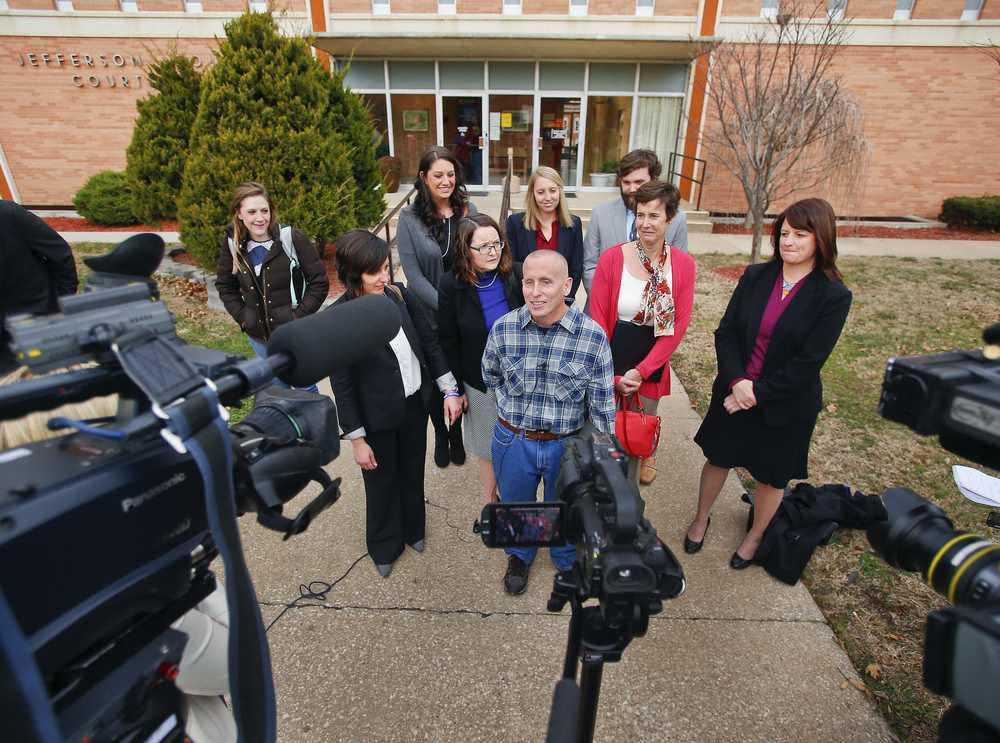Jefferson County faces budget challenge after OKing $7.5M payment to Floyd Bledsoe

- Oops!Something went wrong.Please try again later.
Jefferson County now faces the challenge of budgeting in a manner that will free up $7.5 million for it to pay to Floyd Bledsoe, wrongfully convicted there of murder, its county commission chairman acknowledged Monday.
"We're still trying to figure out how we're going to do some things," Chairman Richard Malm told The Capital-Journal.
Commissioners voted last week to offer the settlement to Bledsoe, 46, who was released from prison in 2015 after DNA evidence proved he couldn't have killed his sister-in-law, 14-year-old Camille Arfmann, in 1999 in Oskaloosa.
Bledsoe will be paid $1.5 million initially, with the rest coming over the next 10 years. The commission would have had to propose a bond if Bledsoe hadn't agreed to accept that arrangement.
Jefferson County's 2023 budget authority for expenses totals about $26.9 million, according to a State of Kansas website.
Malm said reaching the settlement was important because it enables Jefferson County officials to put the situation behind them.
"This has been hanging over our heads for quite a while," he said.
More: Four Shots in Oskie - Part 1: The confessions of Tom Bledsoe
Why did Floyd Bledsoe go to prison?
The agreement ended a nearly seven-year legal battle over a federal lawsuit Bledsoe filed in 2016 alleging the Jefferson County Sheriff's Department fabricated evidence against him and suppressed evidence in his favor.
Bledsoe was 23 when he was convicted in May 2000 of the murder of Camille, 14, who had been shot four times, including once in the back of the head.
Camille had been living at the time with Bledsoe; her sister, Heidi Bledsoe, who was then married to Floyd Bledsoe; and Floyd and Heidi Bledsoe's two young sons. Heidi Bledsoe later divorced Floyd Bledsoe.
Floyd Bledsoe was a hired hand at a McLouth dairy at the time at Camille's death. His brother, Tom Bledsoe, then 25, was a security guard at Lawrence's Farmland Industries.
Camille was a student at Oskaloosa High School. Soon after she was killed, Tom Bledsoe confessed to the crime.
But Jefferson County officials responded by staging a "false recantation," said the lawsuit petition Floyd Bledsoe filed in 2016.
"In the weeks that followed, the defendants continued to fabricate and shape Tom’s story to fit facts emerging from the criminal investigation and silenced Tom when he repeatedly tried to come clean," it said.
Floyd Bledsoe was convicted after a trial that court records said "included recitations of statements made by Floyd's 2-year-old son, Cody, which implicated Tom and Floyd alternatively."
While the boy didn't testify at trial, Heidi Warren testified there that he initially told her he saw "Tom" kill Camille, then changed that to say he saw "daddy" commit that crime.
Floyd Bledsoe was convicted of first-degree murder, aggravated kidnapping and aggravated indecent liberties with a child.
How was Floyd Bledsoe exonerated?
During his years in prison, Bledsoe was kept in "harsh, dangerous and isolating" conditions, his lawsuit petition said.
"Plaintiff had been convicted of a horrific crime — sexually abusing and killing a young girl — and had to endure the humiliation and injustice of being wrongly branded a 'sex offender' and a murderer," it said. "Because Floyd had been sentenced to life in prison, he feared that he would die alone inside the prison walls."
The Project for Innocence commissioned new DNA testing done in 2015 that showed Tom Bledsoe, had likely killed Camille and that Floyd couldn't have been the killer.
As Jefferson County sheriff’s officials reopened the case, Tom died of suicide by asphyxiation in November 2015 in Bonner Springs and confessed to the murder in three suicide notes.
Who did Floyd Bledsoe sue?
Floyd Bledsoe was released from prison in December 2015.
He filed a lawsuit in May 2016 alleging his constitutional rights had been violated by Jefferson County and 11 named defendants.
Those were the following:
• Roy Dunnaway, who was Jefferson County sheriff in 2000. Dunnaway died in 2017.
• Jeff Herrig, who was Jefferson County undersheriff in 2000 and is now the county's sheriff.
• Randy Carreno, Troy Frost, Orin Turner and Robert Poppa, who were all employed at the time by the Jefferson County Sheriff's Department.
• Jim Vanderbilt, then-Jefferson County attorney.
• Mike Hayes, who was Tom Bledsoe's criminal defense attorney.
• George Johnson, Jim Woods and Terry Morgan, then officers for the Kansas Bureau of Investigation.
• An unspecified number of unnamed officers for the Jefferson County Sheriff's Department and KBI.
The settlement agreement arranges for all defendants who were Jefferson County employees to be removed as defendants in the lawsuit, Malm said.
The state of Kansas in 2019 acknowledged Bledsoe had been wrongfully convicted and granted him total compensation of $1,038,526.95.
Contact Tim Hrenchir at threnchir@gannett.com or 785-213-5934.
This article originally appeared on Topeka Capital-Journal: Floyd Bledsoe wrongfully convicted in Jefferson Co. murder to get $7.5M

